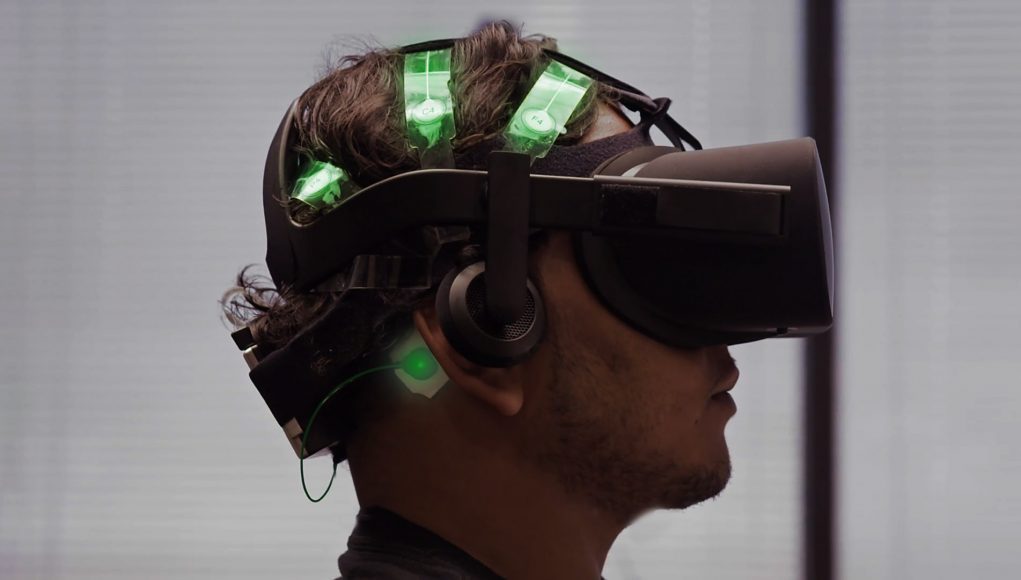A new study on VR motion sickness concludes that certain brain activity detectable by EEG strongly correlates with VR motion sickness. This finding suggests that it’s possible to quantitatively measure and potentially prevent VR motion sickness.
While virtual reality opens the door to incredible possibilities, what we can actually do with VR today is at least somewhat limited by comfort considerations. While developers have steadily invented new techniques to keep VR content comfortable, scientists continue to work to understand the nature of motion sickness itself.
A new study published by researchers at Germany’s University of Jena in the peer-reviewed journal, Frontiers in Human Neuroscience, intentionally induced VR motion sickness in participants while measuring brain activity.
14 subjects were hooked up to an EEG cap and donned a PSVR headset. In the headset the participants were exposed to increasing levels of artificial movement to induce VR motion sickness over the course of 45 minutes. In addition to recording brain activity via EEG, the subjects also subjectively rated their motion sickness symptoms throughout the experiment.
The researchers found a common pattern in the change in brain activity that closely corresponded with the subject’s own perception of motion sickness.
Specifically, the researchers write, “relative to a baseline EEG (in VR) the power spectrum for [brain] frequencies below 10Hz is increased in all brain regions. The increase in frequency power was correlated positively to the level of motion sickness. Subjects with the highest [perception of motion sickness] had the highest power gain in the theta, delta, and alpha frequencies.”
Researchers Matthias Nürnberger, Carsten Klingner, Otto W. Witte, and Stefan Brodoehl offer the following conclusion:
We have demonstrated that VR-induced motion sickness is associated with distinct changes in brain function and connectivity. Here, we proposed the mismatch of visual information in the absence of adequate vestibular stimulus as a major cause according to the model of predictive coding. […] Differentiation which changes in brain activity is due to the sensory conflict or caused by motion sickness should be investigated in further studies. Given the increasing importance of VR, a profound understanding of the constraints imposed by [VR motion sickness] will be increasingly important. Measures to counteract the occurrence of MS or assist in detecting it at an early stage will undoubtedly improve the progress with this promising technology.
The findings offer further evidence that motion sickness can be objectively detected through non-invasive hardware like scalp EEG, which could be used to guide future research into VR motion sickness and VR comfort techniques.
For one, such EEG measurements could be used to objectively evaluate the effectiveness of VR comfort techniques.
Presently developers of VR content employ a variety of well-known VR comfort techniques like snap-turning and teleportation to reduce the odds of VR motion sickness. But not all VR comfort techniques may be equally effective compared either to one another or when compared across individuals. Establishing a quantitative measurement of motion sickness via EEG could help improve VR comfort techniques or even discover new ones by providing clearer feedback while making testing more objective.
Such measurements could also inform comfort ratings as presented to end-users, to help those sensitive to VR motion sickness find appropriate content.
Further, EEG detection of motion sickness could potentially be used on a real-time basis to predict and prevent motion sickness.
EEG brain sensing technology is becoming increasingly accessible and has already been integrated into commercial VR hardware. In the future, headsets equipped with EEG could allow developers to detect a user’s level of motion sickness in real-time, allowing for content adjustments or for VR comfort techniques to kick in automatically to keep users comfortable while they play or work in VR.
Thanks to Rony Abovitz for the tip!







